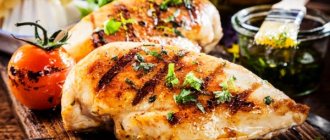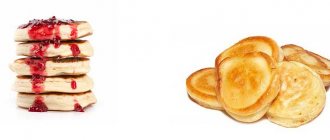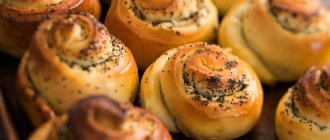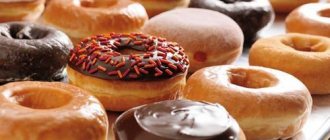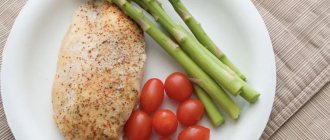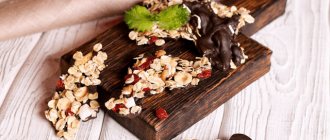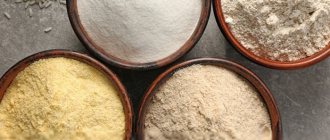Calorie content of buns 339 kcal
Energy value of buns (Ratio of proteins, fats, carbohydrates - bju):
: 7.9 g (~32 kcal) : 9.4 g (~85 kcal) : 55.5 g (~222 kcal)
Energy ratio (b|w|y): 9%|25%|65%
The bun is considered the most common and popular bakery product. The product is prepared from yeast dough. In modern cooking there are many different recipes according to which such products are prepared both at home and in production. The calorie content of a bun, of course, depends on what it is made from. Baking can be sweet, with salt or additives, powders.
Buns are healthy
This bakery product has a high calorie content, hence the conclusion: consuming buns in unlimited quantities is harmful to health.
To prevent the delicacy from affecting your figure, you can consume no more than 100-120 grams of buns per day. At the same time, it is advisable to reduce the amount of other bakery products (bread, pasta, etc.) in your diet. In addition, it should be borne in mind that the calorie content of a jam bun is much lower than the calorie content of a cinnamon bun. That is, how many calories are in a bun, and therefore how much product you can eat, depends on its filling.
During the period of weight loss, it is advisable to completely avoid buns. The fact is that this product is rich in carbohydrates and fats, but practically does not contain protein, which contributes to an increase in fat mass rather than muscle mass.
But for those who suffer from a lack of dietary fats of plant and animal origin, microelements and vitamins, as well as people with poor nutrition, buns will be useful. The filling of the product is also of great importance. For example, cottage cheese contains essential amino acids and lactic acid bacteria, and is rich in calcium and phosphorus. Therefore, pregnant women, children, and people suffering from osteoporosis and disorders of the nervous system can treat themselves to a bun with cottage cheese.
Contraindications to eating high-calorie buns are: diabetes, acute diseases of the gastrointestinal tract, some kidney diseases, severe atherosclerosis, stroke and myocardial infarction.
Almost all buns are rich. They contain flour, yeast, butter, sugar, eggs, and in some cases milk. According to the standard, the amount of sugar and vegetable fats in a bun should be at least 7-8%.
This composition explains the high calorie content of the buns. On average, it is 295 kilocalories per 100 grams of product. If premium flour is used to prepare a bun, the calorie content of the product can reach 340 kcal per 100 grams of product.
How many calories in a bun also depends on its filling - we mentioned this above. Thus, the calorie content of a bun with poppy seeds - one of the most popular buns among children and adults - is 292-300 kcal per 100 grams of product. These products are often served for breakfast with butter. It must be remembered that when calculating the calorie content of such a breakfast, you should take into account not only the calorie content of the poppy seed bun, but also the calorie content of the butter.
The calorie content of a bun with jam is slightly lower - 245 kcal per 100 grams of product. But the rule that you can consume no more than 100-120 grams of these bakery products per day remains unchanged.
The calorie content of a cinnamon roll is 347 kcal per 100 grams of product. Perhaps these are the highest calorie buns. Therefore, it is advisable to pamper yourself with them as rarely as possible. And those who are on a diet should completely give up this sweetness for a while.
Most people love sweets, so various goodies often end up on the kitchen table. The most popular baked goods, and the leader are buns with poppy seeds, which children and adults often snack on. However, consuming this delicacy can negatively affect your slim figure.
.
The calorie content of a large poppy seed bun, which weighs approximately 100 grams, is about 310 kcal.
It contains
:
- 8.3 g fat;
- 12.4 gr. proteins;
- 61.2 gr. carbohydrates.
The bun, like any flour product, is rich in microelements, vitamins E and PP, niacin, thiamine and riboflavin. But everything is ruined by a large amount of empty carbohydrates
. Therefore, those who do not want to gain weight are not recommended to consume such baked goods.
Fillings and forms
Buns are prepared using different fillings. Jam, cottage cheese, cheese, potatoes, and cabbage are often used. The calorie content of the product depends on the filler. Buns can have different shapes:
- round;
- square;
- oblong;
- in the form of a braid;
- in the form of bagels;
Different doughs are used to make buns. One of them is puff pastry, which is quite difficult to prepare. Yeast dough is popular and is used to make confectionery products. The baked goods turn out fluffy and tasty.
Yeast dough can be sponged or unpaired. After kneading, chemical processes take place inside the mixture, due to which the dough grows and the buns become fluffy. A lot of butter or vegetable oil is usually not added to such a mixture, because of which the consistency becomes heavier and the fluffiness is eliminated.
Beneficial features
It is believed that baked goods are harmful to health. This is not entirely true, because baking contains vitamins and valuable substances. Of course, the vitamin and mineral composition can be different, because everything depends on the ingredients used during cooking.
Rye flour-based buns contain vitamins B and E, as well as other beneficial substances and minerals, including magnesium, phosphorus, iron, manganese, zinc, potassium and copper. The calorie content of this product is also low - about 149 kcal. The benefits from this product will be greater than from buns made from wheat flour.
Buns with additives
There are certain types of buns with various additives. Their calorie content depends on additional ingredients:
Caloric content of foods may vary depending on what the manufacturer has added to them.
Most people love sweets, so various goodies often end up on the kitchen table. The most popular baked goods, and the leader are buns with poppy seeds, which children and adults often snack on. However, consuming this delicacy can negatively affect your slim figure.
.
The calorie content of a large poppy seed bun, which weighs approximately 100 grams, is about 310 kcal.
It contains
:
- 8.3 g fat;
- 12.4 gr. proteins;
- 61.2 gr. carbohydrates.
The bun, like any flour product, is rich in microelements, vitamins E and PP, niacin, thiamine and riboflavin. But everything is ruined by a large amount of empty carbohydrates
. Therefore, those who do not want to gain weight are not recommended to consume such baked goods.
Harm
Most people in our country love buns made from white wheat flour. But such products are contraindicated for obese people. Baking negatively affects digestion and figure. Excessive consumption of baked goods causes weight gain, which creates additional stress on the musculoskeletal system and cardiovascular system.
Still, buns are an excellent snack, especially if you need to quickly cope with hunger.
Most of us have a sweet tooth to one degree or another. Therefore, all sorts of goodies come to our table at different intervals: chocolate, caramel, ice cream, cookies and, of course, a variety of baked goods. Buns are especially popular among the latter. They differ in shape, size, smell, color, filling. But all buns are loved by both children and adults.
Many people with a sweet tooth know from their own experience how sweets affect their figure. It is not surprising that sooner or later they ask themselves the question: how often and in what quantities can they eat buns in order to pamper themselves and not gain extra pounds? Let's try to figure it out.
Butter buns
These are considered the most popular delicacies. They are prepared with poppy seeds, raisins, and other fillings and sprinkles. The products contain some vitamins and minerals. The calorie content of a bun with poppy seeds is 335 kcal per 100 g of product. Such baked goods contain proteins (7.7 g), fats (10.9 g) and carbohydrates (51.7 g). The calorie content of a bun with poppy seeds is quite high, but this snack is filling and tasty.
Baking has been prepared in Russia since ancient times. Vanilla, cinnamon, and almond essences were added to these baked goods. The dough is prepared by adding milk, eggs and butter to the flour. It must rise more than 2 times for the buns to be fluffy. Calorie content is approximately 339 kcal, although here, again, everything depends on the amount of certain ingredients.
To prevent such delicacies from affecting your figure, you can consume no more than 100-200 grams of the product per day. It is important to reduce the amount of other baked goods, such as bread and pasta. When losing weight, it is better to avoid such foods altogether, since it is unlikely that you will be able to lose excess weight. This is due to the high content of carbohydrates, which increases the volume of subcutaneous fat deposits.
Calorie content of buns depending on type
One white bun contains 245 kcal and 9.48 g of protein, 1.83 fat and 46.58 g of carbohydrates.
The most common types of baked goods are:
butter;
Below is the calorie content per 100 grams. To find out how many calories are in one product, you need to weigh the product and enter the data into an online calculator.
Bran
This type of product contains fewer calories than others. Such products are made from the following ingredients:
- bran;
- wheat flour;
- salt;
- Sahara;
- purified water.
100 grams of this product contains 220 kcal. BJU: 7.8/1.8/43.9.
Butter
The category of these baked goods includes muffins with raisins, poppy seeds, buns with sugar, and puff pastry buns. They sometimes add cinnamon and vanilla to add flavor. The dough for their preparation contains a lot of butter, eggs and milk. To give a golden crust, the baked goods are greased with melted butter.
Products may contain jam, honey. 100 grams of product contains 339 kcal and the following BJU content: 7.9/9.4/55.5.
Capital
Such products contain a large amount of mineral components and vitamins. One white loaf eaten for lunch will replenish your iron requirement for the day. They include:
- purified water;
- margarine;
- white durum wheat flour;
- sugar;
- yeast;
- salt.
100 g contains 270 kcal. BJU: 8.4/2.2/52.8. Similar products are used for making sandwiches and sandwiches, but it should be remembered that adding jam, cheese and honey will increase the calorie content of the bun.
Eight grains
Such bakery products belong to the category of healthy food products. They are made from 8 types of flour and the same amount of cereals. In their composition you can find:
- brown flax seeds;
- extruded corn;
- wheat and soy flakes;
- buckwheat;
- sesame and other ingredients.
The product contains 277 kilocalories, BJU composition: 13.9/5.3/43.7.
Burgundian
The second name for products of this type is gougere, which translated means cheese pie. These buns are served in restaurants when ordering glasses of wine. The products taste creamy and airy. They are made from choux pastry with the addition of cheese.
The number of kcal in Burgundy buns is 266. Nutritional value is 0.7/1.7/55.
Sandwiches
Bakery sandwich products with the addition of sesame are made from the following components:
- premium wheat flour;
- baking improver;
- drinking water;
- Sahara;
- baker's yeast;
- salt;
- sunflower oil.
These buns cannot be stored for more than a day. 100 g of sesame products contain 320 kcal. BJU: 9.6/4.2/59.5.
For hamburgers
The chemical composition of buns includes sodium, phosphorus, iron and other equally important minerals. Hamburger baked goods are baked from the following ingredients:
- wheat flour;
- butter;
- milk;
100 g of product contains 272 kcal. Nutritional value of the product: 7/4/52 g.
For hot dogs
The hot dog product can be identified by its oblong shape. Buns are prepared from vegetable oil, milk, eggs, and wheat flour. The chemical composition is enriched with a large number of B vitamins, as well as:
- potassium;
- calcium;
- magnesium;
- retinol;
- nicotinic acid.
100 grams of product contains 339 kcal. The bun contains 8.7g protein, 7.5g fat and 60.6g carbohydrates.
